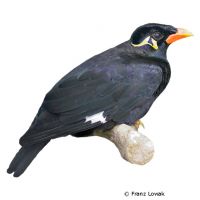Hill Myna (intermedia) (Gracula religiosa intermedia)
| Hill Myna (intermedia) Gracula religiosa intermedia | |
|---|---|
| Name | Hill Myna (intermedia) |
| Name Lat. | Gracula religiosa intermedia |
| Family | Starlings and Allies |
| Family lat. | Sturnidae |
| Order | Perching Birds |
| Order lat. | Passeriformes |
| Origin | Southeast Asia |
| Climate | Subtropical - tropical |
| Diet | Myna soft food, fruits |
| Keeping | Pair, group |
| Care Level | Moderate |
| Reproduction | Cavity nest |
| Life Span | 12-15 years |
| Protection | CITES Appendix II; EC Annex B |
| Metric Units | |
| Size | 27 cm |
| Temperature | Room temperature |
| Housing | 200 x 100 x 150 cm |
| US Units | |
| Size | 10.6" |
| Temperature | Room temperature |
| Housing | 80" x 40" x 60" |
Distribution and habitat
The range of the Middle Beos extends from northern India through Myanmar, Thailand and Vietnam to Malaysia. The sociable animals live mostly in small groups in the rainforests and semi-humid forests in the lowlands and mountains
Cage size
The recommended minimum cage size is 2.0 x 1.0 x 1.5 m (L x W x H) for 1-2 animals. The cage size must not be undercut even in case of justified single keeping. For an additional 2 birds, assuming species compatibility, the footprint must be increased by 25%. The cage must be placed in a bright, draught-free and quiet place, have a rectangular base and be opaque on one side
Maintenance
The floor must be covered with sand, wood granules or a similar absorbent material and cleaned regularly (thin droppings). They need a sleeping house and a bathing facility must be available at all times. At least 3 perches made of wood or branches of different thickness and height must be installed in such a way that they can only be reached by flying, a flight distance as long as possible is created, and soiling of the feed and water containers is also prevented. The room temperature must not fall below 15 °C.
Diet
They are soft feeders. The species-specific food supply consists of commercial "soft food for beos" or "Beo dry food" (beads, granules), which must be soaked in water. In addition, they need soft, chopped fruits, such as bananas, grapes, figs, cherries, berries, and grated apples and pears, etc., and occasionally raisins soaked in water or fruit juice as a treat. Live insects, such as mealybug larvae, house crickets, zophopas, etc., are also readily accepted, depending on the individual. Especially for rearing young, the feed should be enriched with hard-boiled, crushed hen's egg, lime and vitamins. Vitamin lime, shell grit and fresh forest soil are needed as digestive aids. Drinking water must always be available in stable, open containers and, like feed, must be offered fresh daily in clean containers
A varied diet promotes health and prevents deficiency symptoms.
Reproduction and breeding
Males and females are colored the same and can hardly be distinguished externally
They breed in nest boxes or in hollowed tree trunks. Leaves and small branches are brought in for padding. The clutch consists of 2-3 eggs, the brood duration is 13-17 days. Young birds must be raised so that they are species-specific. Hand rearing may be done only in justified exceptional cases. The life expectancy can be 15 years.
Species protection
The animal population must be reported in writing to the competent authority immediately after the start of keeping. Your pet store will be happy to provide you with further information.
Protection of species: WA Appendix II; EU Appendix B. The proof of purchase is the required proof of origin for the animal. Please keep it in a safe place!
Important
Beos can imitate various sounds and also the human voice. They may only be kept in pairs or in a group. During the breeding season, due to their aggressive behavior towards beos or other small birds, they can only be kept in pairs.
When kept in outdoor aviaries, they also need a heated shelter with a floor area of at least 1 m², which can be visited by the birds at any time. The temperature in the shelter must not fall below 15 °C and the furnishings must correspond to those of cage keeping
Sufficient daylight or flicker-free artificial light (stroboscopic effect) corresponding to the light spectrum of natural sunlight must be provided in rooms, including shelters. The lighting duration must be between 8 and 14 hours per day. The day-night rhythm must be observed. An adequate room climate must be provided. If caged, they should be allowed regular indoor free flight. The health condition of the birds should be checked daily
Further literature can be found in your pet store
References
Text: Othmar Sieberer; Image: Franz Lowak
Source: BMELV (1995): Tierschutzgutachten - Mindestanforderungen an die Haltung von Kleinvögeln; ROBILLER (1986): Lexikon der Vogelhaltung, Edition Leipzig; GRUMMT & STREHLOW (2009): Zootierhaltung - Tiere in menschlicher Obhut: Vögel, Verlag Harri Deutsch
- Gemäß § 21 Abs. 5 Tierschutzgesetz idgF
